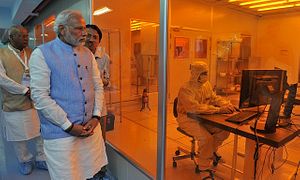When Indian Prime Minister Narendra Modi launched his Make in India campaign, it was to considerable fanfare. However, the idea has yet to really take off. The perception is that while the central government is trying to do its bit to make India a better place to do business, there are numerous issues that need to be solved at the local level. Doing business in India still requires the entrepreneur to be familiar with the morass of rules issued the central government, state governments, and municipalities.
Indian policymakers must therefore address the domestic constraints that diminish India’s trade competitiveness and that make it difficult to participate in global production networks. This is particularly relevant at a time when India’s trade figures are slowing (for fiscal 2015, exports are already down 1.2 percent, to $310.5 billion, in spite of rupee depreciating).
In this respect, India should learn from its Southeast Asian counterparts, a number of which have been to successfully implement Made in ASEAN. They have been able to do this by participating in the Southeast Asian production network. When a computer or cell phone is assembled, the constituent parts come from across the Southeast Asian region. Although the ASEAN community is diverse, and companies in many ASEAN countries compete fiercely and often lobby against their rivals, there are trading complementarities. Southeast Asia has been able to make good use of these complementarities.
Complementarities exist in terms of trade in energy, consumer durables, and food items. Consider that Thailand is a major buyer of energy and food items from the ASEAN region. Laos has been supplying hydroelectric power to Malaysia and Thailand. Vietnam ships petroleum and petrol products to Thailand, Laos, and Cambodia. The richer economies within the ASEAN region, such as Singapore, Indonesia, and Brunei have demand for food and clothing, much of which is supplied by Myanmar, Laos, Cambodia, and Vietnam.
For the Make in India campaign to succeed, one approach would be for the Indian government to help the Indian business community participate in ASEAN production networks. That would offer five benefits. First, as the cost of production is lower in Laos, Cambodia and Myanmar, Indian firms could gain significantly by investing in these countries. Second, investing in ASEAN would open up new markets for Indian firms. Third, Indian firms could avoid protectionist measures if they started exporting from within Southeast Asian countries. Fourth, investing in Southeast Asia would also meet some of India’s energy requirements, enabling Indian firms to access cheaper foreign energy (oil and power) and minerals from Cambodia, Myanmar and Vietnam. Fifth, and most importantly, participating in Southeast Asian production networks will enable India to expand its manufacturing base and create new jobs.
Conflicts of interest between Made in ASEAN and Make in India are less likely to arise as both Southeast Asian and Indian manufacturers are likely to embed themselves in each other’s supply chains. For instance, Indian companies can slash costs by manufacturing in Southeast Asian, particularly in Laos, Cambodia and Myanmar, in some cases by 15-20 percent.
There are other complementarities. Energy sources, particularly hydropower on the Mekong river, could help boost India’s fuel hungry economy. India could invest in hydroelectric power projects in Cambodia. With an estimated 8000 megawatts of hydropower potential, Cambodia could become a major supplier for energy for India. With nuclear power yet to fully take off, India needs alternative sources of energy.
The opening up of Myanmar provides a tremendous investment opportunity for Indian firms. India and Myanmar have previously worked together at the government level. In 2002, the Indian government launched a remote sensing and data processing program to help Myanmar with weather forecasting, determination of forest cover, and other land-use applications. Indian firms, such as Larsen and Toubro, Adani Port, and NTPC Limited can bring money and technical expertise to Myanmar, helping it to build infrastructure, such as building container docks and coastal ships, power stations, and cement factories. Indian telecommunications companies such as Bharti Airtel and Reliance Telecommunication, have the expertise to lay the optical fiber cables and telecommunications networks that Myanmar, Cambodia and Laos need.
Indonesia, with around 17,000 islands, is meanwhile building six economic corridors in a bid to become locally integrated and internationally connected. Each of these corridors – Sumatra corridor (for energy reserves), Kalimantan corridor (for mining activities), Sulawesi corridor (for oil and gas exploration), Java corridor, Bali Nusa Tenggara corridor, and Papua Maluku island corridor – offer significant investment opportunities for Indian oil exploration and construction firms, such as Oil and Natural Gas Corporation Limited, Reliance, Bharat Heavy Electrical Limited, and Larsen Toubro. Indian companies already have a number of joint ventures with their Indonesian and Singaporean counterparts. For example, Bajaj Auto is involved in a venture to manufacture two and three wheelers. Other Indian companies with significant investments in Indonesia include Aditya Birla Group (Indo-Bharat Rayon), S. P. Lohia Group (Indo-Rama Synthetics), Ispat Group (Ispat-Indo), and Essar Group (ESSAR Dhananjaya).
Singapore is meanwhile India’s largest trading partner in the ASEAN region. Here, joint ventures are mainly focused on shipping, aviation, automobile and computer accessories, and chemicals. For instance, the Port of Singapore Authority has started investing in the development of sea ports in India’s southern states (Tamil Nadu and Kerala). Tata group from India and Singapore Airlines have jointly launched the airline company Vistara. Sing Tel has invested in India’s Bharti Telecommunication, and Voltas and Dow Chemical Pacific Limited have set up joint venture for a water waste treatment plant.
Certainly, the potential is there for India to become a natural trading partner for the ASEAN region. That, in turn, could help ensure that its Make in India campaign achieves the momentum it needs.
Nilanjan Banik is with Mahindra Ecole Centrale. He is a Fellow at CUTS International and is an ARTNet UNESCAP Researcher. He is the author of The Indian Economy: A Macroeconomic Perspective.

































